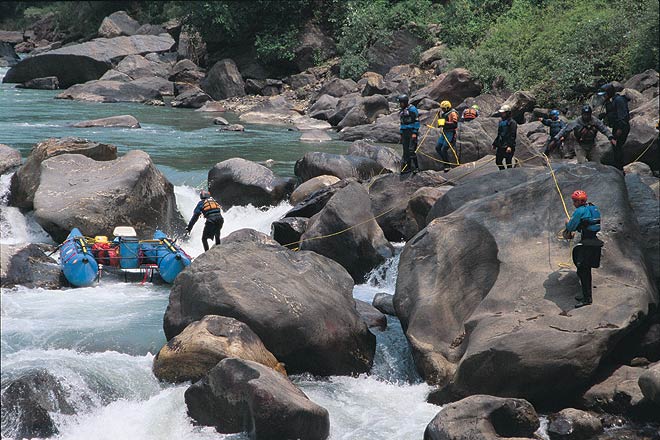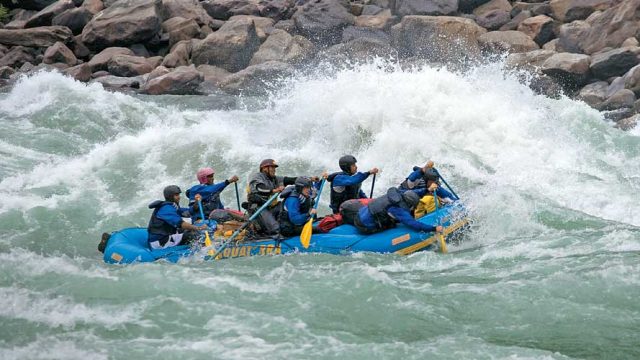Along with about 300 villagers, grey skies greet us at Tiuni Bazaar, where most of the 18-person
One of the junior guides—nearly half the expedition is made up of guides, actually—tries without success to keep curious local youngsters, mostly dressed in raggedy blue school uniforms, away from the rafts. Ignoring him, the children bang on the tight rubber tubes, and shyly caress our whitewater paddles. The mastermind behind this trip, Vaibhav Kala, owner of the Delhi-based Aquaterra Adventures, is downstream with the film crew documenting our effort—billed as the first Indian descent of the Total Tons. Except for an American outfitter who ran the river back in the 1980s, Aquaterra is the only company to attempt to take paying clients all the way from Gyunhatti, at an elevation of 1,134m, to Icchari, at 640m. I cannot escape the feeling that more than a little action lies ahead.

Rushing down from Bandarpoonch Glacier, an icy patch on a mighty 6,216m mountain, the Tons flows from the heights of the Garhwal Himalaya in north India until it reaches the broad Yamuna river. The upper river loses altitude at a comparatively modest 9m per mile before the Tons drops like an anvil, reaching its nadir at a remarkable tilt, falling on average nearly 38m per mile. Obstacles range from house-sized boulders to big bubbling whirlpool eddies to nasty strainers formed by huge half-submerged pines. The Himalayan snow pack is as high as it has been in 50 years, leaving us with mixed emotions regarding the cool spring that has kept the river from becoming an insane torrent. With the water temperature hovering around 14 degrees, a long swim would be bad news; as I discovered on our first training day, even a short swim could also be highly unnerving.
Currently, the river, which has been steadily gaining momentum and flow from our put-in two days ago, appears to be demanding something along the lines of a sacrifice. We’d managed to avoid any mishaps at Class IV Kunighad Rapid, a chute whose name means ‘bloody creek’, the day before, our first of real excitement; two portages have taken place in the meantime. After roping the rafts downstream over a bony drop with lines not even the kayakers dared attempt, we carried the rafts around a constriction known as Main Squeeze, where undercut boulders and swirling hydraulics formed a likely deathtrap for inadvertent swimmers. Given that we are still a 10-plus-hour drive from decent medical help, Kala remains anxious that we take extra care on this five-day commercial-expedition hybrid trip. “Safety first” is more than an idle mantra here.

The river was first attempted in the early 1980s by Californian Jack Morison and his whitewater outfit White Magic, though it took the introduction of newfangled self-bailing rafts in 1984 before Morison got beyond Tiuni Bazaar. Veteran American adventure travel writer Tim Cahill joined Morison in 1986 on what ironically would be the last time anybody would attempt the Tons until now; after years of promoting the river in the States, Morison called it quits in India when the clientele did not arrive. Kala shares the enthusiasm Cahill and Morison manifested way back then, and hopes to finally establish the Tons as India’s answer to global paddling destinations such as the Futaleufu in Chile.
“It’s the consistency of the whitewater,” Kala explains. “We’ve got plenty of big water here in India, but nothing compares to the Tons in terms of the technical nature of this river.” The plan is to cover 90-odd river kilometres over five days—with a film crew documenting the action. Impatience over the filming and the amount of scouting would fuel a campfire debate over whitewater classification as it pertains to India, where wilderness outfitters answer to few authorities. Arguments aside, two decades on, the Tons seems as vengeful as ever.
Curiously enough, according to the Ramayana, the Tons has its true origins not amid the world’s highest peaks but rather in a mythic lover’s quarrel. Given the rough and tumble character of the Tons, the legend provides some insight into local regard for its dark nature. As the story goes, when the demoness Surpanakha fell in love with Lakshman, Ravan was scheming to kidnap Sita. Angered by Surpanakha and Ravan’s shenanigans, Laxman broke things off in dramatic fashion, chopping off the demoness’ nose. They say the Tons has been flowing from her unending tears ever since.

In April, of course, we’re just one of many parties headed into the Himalaya. We encounter herds of goat, cattle, and buffalo driven uphill by Gujar tribesmen, known for their colourful clothing and nomadic lifestyle. Unlike the diminutive local hill tribes, the Gujars are tall and fine-featured. Their shy women offer teasing glimpses of beautiful light eyes. The proud, lean men wear turbans of various hues and boast beards dyed red. Unlike the Hindu pilgrims who also flood the Garhwal Himalaya annually, the Gujars come not for spiritual redemption but to take advantage of cooler weather and greener pastures when the plains heat up. Despite these efforts, much of their livestock appears worse for the wear. Sharp hipbones and xylophone ribcages jut from beneath the dust-coated skin of cows and buffaloes. On scouting breaks, we frequently catch a nauseating whiff of rotting flesh, the remains of animals too lame or rundown to make the trip.
With the rough rapids of Tiuni Bazaar waiting, though, I’m not thinking of religion or livestock. In deference to the film guys, we’ll be running this stretch in stages: first the safety kayaks, then the pontoon boats, followed initially by the other raft and finally our own. The crowd watches in disbelief as the guide Rana peels out of the eddy and disappears downstream; early in the trip, when I asked this whitewater veteran about the challenges of running the Tons, he brightly observed, “On this river, man, shit is happening all the time.” Later, we get a report that the guide was ejected from his raft when it hit the big hole at the bottom of the bazaar. He emerged unharmed, but the rapid was renamed in his honour— Class V (minus) Rana. Soon we’re zinging along the crests of mid-sized waves, hoping to avoid what happened to Rana. A two-hour scout concludes with a 10-minute adventure—and with Tiuni conquered, the day’s float ends.
On the fourth day, we leave the alpine zone and find more tropical climes, and the air heats up while the Tons seems to mellow. We hit several rapids in succession, but not very many higher than Class III, which are manageable; river classifications run from I, the easiest, to IV, which are considered impossible. We scout the once fearsome Roaring Baghni (means ‘tigress’), which turns out to be more of a playful kitten. White-water of varying difficulty continue to rock our boat as we continue to descend during the next day and a half, and the scenery of the lower Tons helps buoy our spirits as we approach the take-out and the end of our adventure. Palms and cacti replace the big chir and rhododendron trees. High jinks ensue as the safety kayakers target the raft guides for rough play; an attempt at boarding Rana’s raft results in my taking another unplanned bath.
When we finally reach the last of the big rapids, the Class V Major Surprise, it looks potentially doable, but nobody has the stomach for the risk. Sweeping around a big bend, Major Surprise requires an evasive right-hand turn to avoid a 10-foot pillow pressed against a 30-foot boulder; then there’s a drop into an ugly hole, requiring perfect precision because afterward combined currents sweep into a second, more brutal hole. Anybody out of the raft here would be re-circulated indefinitely through a churning eddy. Tim Cahill describes his experience swimming the rapid as follows, “The phrase ‘holy shit, this is serious’ began ringing through my mind. It was high noon and, even underwater, I could see the bright mountain sun above… It was a bad dream, a real toothgrinder, and I longed to rise to the light, to breathe, to break through to the other side, the other side of the sun.” Our group ultimately cheats such visions of a watery death, but regardless safely running the Tons adds significantly to my appreciation of life.
The information
Aquaterra Adventures organises the ‘Total Tons’ river expedition once every year. Previous white-water experience is a must and this is the only trip where they will not take down first-time rafters. You’ll run many rapids ranging from Class III to Class IV+/V, with whitewater sections separated by less than 100 yards of flat water. Contact: (011-29212641/981110383, www.treknraft.com). For people with limited rafting experience there is the option of the lower Tons rafting expedition. Operators who organise this trip include the Himalayan River Runners (011-26852602, www.hrrindia.com) and Great Indian Outdoors (011-2689 1626, www.greatindianoutdoors.com).
Tons River rafting
Whitewater rafting in Uttarakhand
Leave a Reply
You must be logged in to post a comment.



